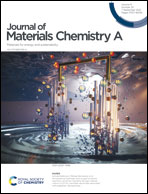Characterization of the interfacial Li-ion exchange process in a ceramic–polymer composite by solid state NMR†
Abstract
Solid-state electrolytes are key for the development of high energy density and safe Li-batteries. A very strong research effort has been made for the development of ceramic–polymer composite solid electrolytes that combine the high ionic conductivity of the ceramic phase with the ease of processability of the polymeric membrane. A crucial question for the development of such composite membranes is the detection and quantification of the Li-ion exchange processes existing at the interface between the polymer and ceramic particles. Using multidimensional solid-state NMR experiments, we unequivocally demonstrate and characterize in this work the Li-ion exchange process present in a PEO:LiTFSI–LLZO composite material. The exchange process is observed between bulk Li-ion populations in both phases, and is not only restricted to the exchange processes occurring at the interface. LiOH is detected in the composite material and its role in the polymer–ceramic Li-ion exchange process is discussed. The results obtained in this work illustrate the suitability of solid-state NMR for the characterization and rational design of interfacial Li-ion exchange properties in next generation polymer–ceramic composite materials.



 Please wait while we load your content...
Please wait while we load your content...